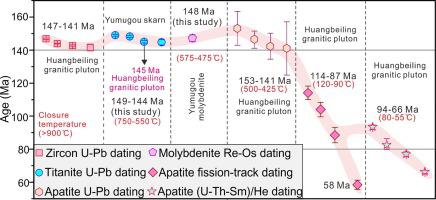榆木沟钼钨矿床是东秦岭世界级栾川钼多金属群中的重要斑岩矽卡岩矿床。然而,矽卡岩钼矿化的成因和年龄,以及鱼木沟斑岩-矽卡岩系统的时间演化、氧化还原条件和岩浆-热液过程仍然是个谜。为此,我们对鱼木沟矿床斑岩和矽卡岩进行了辉钼矿 Re-Os 和榍石 U-Pb 定年以及榍石地球化学研究,旨在解决鱼木沟矿床的生命周期和演化过程,并为岩浆岩浆提供新的见解。 -区域栾川斑岩-矽卡岩系统的热液演化。含钼二长花岗岩的钛铁矿 U-Pb 测年产生了 145.0 Ma 的较低截距年龄,与报道的黄背岭侵入体的锆石(147-141 Ma)和磷灰石(153-141 Ma)U-Pb年龄一致,被解释为响应花岗斑岩浅层侵位的快速岩浆后冷却。矽卡岩的钛铁矿 U-Pb 测年得出的钛矿 U-Pb 较低截距年龄为 149.0-144.7 Ma,代表了多次热液事件的时间。钼基矽卡岩的辉钼矿 Re-Os 测年得出的加权平均年龄为 147.2 Ma,我们将其解释为矽卡岩钼矿化的年龄。结合已发表的玉木沟矿床年龄数据,我们认为玉木沟斑岩-矽卡岩系统在大约 100 年经历了岩浆侵位。147-141 Ma,同时期的矽卡岩化、Mo 矿化和 ca 的快速后岩浆冷却。153-141 Ma,以及多次矿化后冷却和大约在 ca。114-58 马。汇编的辉钼矿 Re-Os 同位素数据表明了所有 Mo-W 矿床的壳幔混合 Mo 来源,并与栾川花岗斑岩和矽卡岩热液 Pb-Zn-Ag 矿床的壳幔混合岩浆和成矿物质相结合地区,我们提出栾川斑岩-矽卡岩系统共享单一来源。此外,榍石结构和地球化学数据表明,玉木沟矿床大部分榍石为热液成因,主要在还原条件下形成。结合东秦岭造山带的构造演化,我们认为玉木沟 Mo-W 矿床形成于从同碰撞到后碰撞构造(160-130 Ma)的构造转变过程中,通过熔体和热液的多重相互作用,Mo 并结合栾川地区花岗斑岩和矽卡岩-热液型铅锌银矿床壳幔混合岩浆和成矿物质,提出栾川斑岩-矽卡岩系统具有单一来源。此外,榍石结构和地球化学数据表明,玉木沟矿床大部分榍石为热液成因,主要在还原条件下形成。结合东秦岭造山带的构造演化,我们认为玉木沟 Mo-W 矿床形成于从同碰撞到后碰撞构造(160-130 Ma)的构造转变过程中,通过熔体和热液的多重相互作用,Mo 并结合栾川地区花岗斑岩和矽卡岩-热液型铅锌银矿床壳幔混合岩浆和成矿物质,提出栾川斑岩-矽卡岩系统具有单一来源。此外,榍石结构和地球化学数据表明,玉木沟矿床大部分榍石为热液成因,主要在还原条件下形成。结合东秦岭造山带的构造演化,我们认为玉木沟 Mo-W 矿床形成于从同碰撞到后碰撞构造(160-130 Ma)的构造转变过程中,通过熔体和热液的多重相互作用,Mo 我们提出栾川斑岩-矽卡岩系统具有单一来源。此外,榍石结构和地球化学数据表明,玉木沟矿床大部分榍石为热液成因,主要在还原条件下形成。结合东秦岭造山带的构造演化,我们认为玉木沟 Mo-W 矿床形成于从同碰撞到后碰撞构造(160-130 Ma)的构造转变过程中,通过熔体和热液的多重相互作用,Mo 我们提出栾川斑岩-矽卡岩系统具有单一来源。此外,榍石结构和地球化学数据表明,玉木沟矿床大部分榍石为热液成因,主要在还原条件下形成。结合东秦岭造山带的构造演化,我们认为玉木沟 Mo-W 矿床形成于从同碰撞到后碰撞构造(160-130 Ma)的构造转变过程中,通过熔体和热液的多重相互作用,Mo4+在还原条件下聚集 S 2–在花岗斑岩和矽卡岩中以辉钼矿 (MoS 2 ) 的形式沉淀。此外,我们还认为类似的钼富集过程可能发生在整个东秦岭造山带。
 "点击查看英文标题和摘要"
"点击查看英文标题和摘要"
Temporal evolution and origin of the Yumugou Mo-W deposit, East Qinling, China: Evidence from molybdenite Re-Os age and U-Pb dating and geochemistry of titanite
The Yumugou Mo-W deposit is an important porphyry-skarn deposit hosted in the world-class Luanchuan Mo polymetallic cluster, East Qinling, China. However, the origin and age of skarn Mo mineralization, as well as the temporal evolution, redox conditions and magmatic-hydrothermal processes of the Yumugou porphyry-skarn system remain enigmatic. Hence, we conducted molybdenite Re-Os and titanite U-Pb dating together with titanite geochemical studies on porphyry and skarn from the Yumugou deposit, with major view to resolve the life-cycle and evolution of the Yumugou deposit and to provide insights into the magmatic-hydrothermal evolution of regional Luanchuan porphyry-skarn system. Titanite U-Pb dating of Mo-hosting monzogranite yielded a lower intercept age of 145.0 Ma, consistent with reported zircon (147–141 Ma) and apatite (153–141 Ma) U-Pb ages of the Huangbeiling intrusion, interpreted as rapid post-magma cooling in response to shallow emplacement of granitic porphyries. Titanite U-Pb dating of skarns yielded titanite U-Pb lower intercept ages of 149.0–144.7 Ma, representing the timing of multiple hydrothermal events. Molybdenite Re-Os dating of Mo-hosting skarns yielded a weighted mean age of 147.2 Ma, which we interpret as the age of skarn Mo mineralization. Together with published age data of the Yumugou deposit, we suggest that the Yumugou porphyry-skarn system underwent magma emplacement at ca. 147–141 Ma, contemporaneous skarnization, Mo mineralization and rapid post-magma cooling at ca. 153–141 Ma, and multiple post-mineralization cooling and exhumation at ca. 114–58 Ma. Compiled molybdenite Re-Os isotopic data indicate crust-mantle mixed Mo source for all Mo-W deposits, and coupled with crust-mantle mixed magma and ore-forming materials of granitic porphyries and skarn-hydrothermal Pb-Zn-Ag deposits in the Luanchuan region, we propose that the Luanchuan porphyry-skarn system shares a single source. In addition, titanite textures and geochemical data suggest most titanites from the Yumugou deposit are of hydrothermal origin and mainly formed under reduced conditions. In conjuction with tectonic evolution of the East Qinling Orogen, we argue that the Yumugou Mo-W deposit formed during the tectonic transition from syn- to post-collisional settings (160–130 Ma), via multiple interactions of melt and hydrothermal fluids, Mo4+ aggregates S2– under reduced conditions to precipitate as molybdenites (MoS2) in granitic porphyries and skarns. Further, we also suggest that similar Mo enrichment processes likely occurred throughout the whole East Qinling Orogen.























































 京公网安备 11010802027423号
京公网安备 11010802027423号